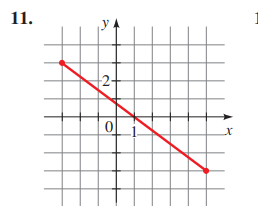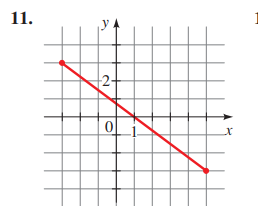
Concept explainers
To calculate: The distance between the pair of points that are graphed below.

Answer to Problem 11E
The distance between the pair of points is
Explanation of Solution
Given information:
The points are depicted graphically,

Formula used:
Distance
Calculation:
Consider the points that are depicted graphically,

The two points are
Recall that the distance
Evaluate the distance between
Thus, the distance between the pair of points is
To calculate: The midpoint of the segment that joins the pair of points that are graphed below.

Answer to Problem 11E
The midpoint of the segment that joins the pair of points is
Explanation of Solution
Given information:
The points are depicted graphically,

Formula used:
Midpoint of the segment that joins two points
Calculation:
Consider the points that are depicted graphically,

The two points are
Recall that the midpoint of the segment that joins two points
Evaluate the midpoint of the segment that joins
Thus, the midpoint of the segment that joins the pair of points is
Chapter 1 Solutions
Precalculus - A Custom Text for UNLV
- 5 2 3. f(x) = 3x3 - 15x3 Find the intervals of increasing, decreasing 4. If xy+cos y, Findarrow_forward#IN A [2 pts.] C 0 II. Consider the circle C r = 4 cos 0 and the line Cr=sec as in the figure on the right. Let A and B be the points of intersection of the two curves as shown. 1. Find the polar coordinates of A and B. 2. Find a Cartesian equation of the tangent line to C at the point where [4 pts.] 3. Set up (and do not evaluate) a definite integral or a sum of definite integrals that yields the follow- ing: a. the length of the portion of C traced counterclockwise from A to B. b. the area of the shaded region. [2 pts.] [3 pts.] B Carrow_forwardI. Perform the following integrations. 1. L' (2x + 1)e³r da cot³ (ln x) csc³ (ln x) 2. dx х 3. 4. x² √1-92 dx 3x3 +14x+7 x² (x²+7) dxarrow_forward
- IV. Consider the equation : y + z = 2. 1. Sketch a portion of the graph of π in the first octant in R3. Indicate proper rulings. [2 pts.] 2. Find an equation of the surface generated by revolving the trace of π on the the yz-plane about the y-axis. Sketch the surface of revolution. [3 pts.]arrow_forwardIV. Consider the function f(x) = esin 2x 1. Find the second-degree Maclaurin polynomial of f(x). 2. Approximate esin 0.02 using the result in IV.1. Express your answer in decimal form.arrow_forwardIII. Find the center-radius form of the equation of the sphere having the line segment with endpoints P(1,-2, 1) and Q(5, 0, 1) as a diameter. [2.5 pts.]arrow_forward
- II. Determine if the improper integral is convergent or divergent. 0 2x2 L dx -2 x3+8arrow_forward2+5n2 1. Determine whether the sequence (b) converges or diverges. 2. Determine whether the following series converge or diverge. State the test you us 3n² - n I. Let bn = for n N with n ≥ 1. نے n=1 8 b. (bn)" n=1arrow_forwardII. Determine whether the following series converge or diverge. State the test you used. (4/2/3 po 1 1. n(Inn)2 n=3 2. 8 IM n=1 5" + sin² n 3n 00 1.3 " 3. (2n − 1) (n + 2)! - n=1arrow_forward
- 7. Consider the following parametric curve: x = sint, y = 2 cost, for 0 ≤t≤ a) Eliminate the parameter to find a rectangular equation for the curve. b) Use the parametric equations to find the slope of the tangent line when t = c) Use the parametric equations to set up an integral to represent the arc length of the curve. You do not need to evaluate the integral.arrow_forward10. Consider the polar equation r = sin² (2) a) Find the (rectangular) equation of the tangent line when 0 => b) Set up an integral to represent the arc length of the curve for 0arrow_forward2. Which of the following differential equations has the direction field shown? Explain your answer and support it with calculations. Full credit will not be given without sufficient justification. a) y' = x + 2y 31 12 b) y' = y - ¹× c) y' = (x + 1)(y+1) / 1 +-2 1-311 Harrow_forwardarrow_back_iosSEE MORE QUESTIONSarrow_forward_ios
 Calculus: Early TranscendentalsCalculusISBN:9781285741550Author:James StewartPublisher:Cengage Learning
Calculus: Early TranscendentalsCalculusISBN:9781285741550Author:James StewartPublisher:Cengage Learning Thomas' Calculus (14th Edition)CalculusISBN:9780134438986Author:Joel R. Hass, Christopher E. Heil, Maurice D. WeirPublisher:PEARSON
Thomas' Calculus (14th Edition)CalculusISBN:9780134438986Author:Joel R. Hass, Christopher E. Heil, Maurice D. WeirPublisher:PEARSON Calculus: Early Transcendentals (3rd Edition)CalculusISBN:9780134763644Author:William L. Briggs, Lyle Cochran, Bernard Gillett, Eric SchulzPublisher:PEARSON
Calculus: Early Transcendentals (3rd Edition)CalculusISBN:9780134763644Author:William L. Briggs, Lyle Cochran, Bernard Gillett, Eric SchulzPublisher:PEARSON Calculus: Early TranscendentalsCalculusISBN:9781319050740Author:Jon Rogawski, Colin Adams, Robert FranzosaPublisher:W. H. Freeman
Calculus: Early TranscendentalsCalculusISBN:9781319050740Author:Jon Rogawski, Colin Adams, Robert FranzosaPublisher:W. H. Freeman
 Calculus: Early Transcendental FunctionsCalculusISBN:9781337552516Author:Ron Larson, Bruce H. EdwardsPublisher:Cengage Learning
Calculus: Early Transcendental FunctionsCalculusISBN:9781337552516Author:Ron Larson, Bruce H. EdwardsPublisher:Cengage Learning





